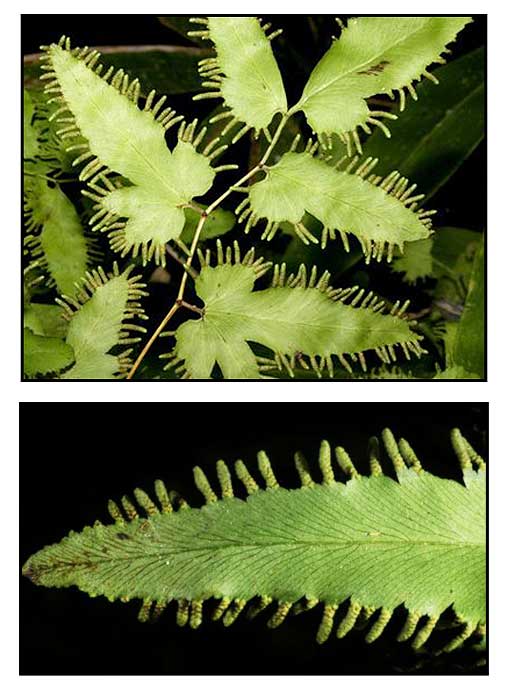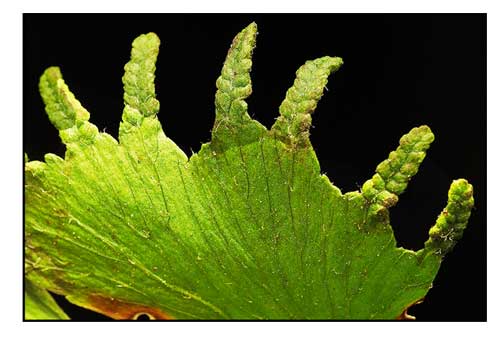|  Gen info Gen info
• Schizaeaceae is a family of fern in the order Schizaeales. It includes only two genera. Species are mainly distributed in the tropics, but several are found in temperate regions in North America, South Africa, Australasia and Northeast Asia. (8)
• Lygodium flexuosum, also known as the flexuose climbing fern, is a rhizomatous perennial climbing fern native to tropical and subtropical Asia and northern Australia.
• Some botanists consider it the sole genus in the family Lygodiaceae.
• Etymology: The genus name Lygodium translates to twining one, referring to the climbing habit of the fern. The species epithet flexuosum, refers to the zigzag, winding rachis of the plant. (1)
 Botany Botany
• Nito-nitoan is a fern with dark brown slender rhizomes and climbing, twining fronds, Primary petioles are very short, the secondary
ones 1 to 2 centimeters long. Sterile pinnae are 7 to 20 centimeters long, with a
terminal, simple or bifid pinnule and 4 to 6 lateral ones on each
side. Pinnules are alternate and stalked, 2 to 3.5 centimeters long, oblong
or subtriangular, simple, entire or sometimes slightly lobed, with
the base variable, rounded, truncate, cordate, or bluntly hastate. Fertile pinnules are commonly shorter. Spikes are 2.5 to 7.5 millimeters long in close
rows. Spores are reticulate.
• Lygodium flexuosum is a rhizomatous perennial climbing fern. It produces thin, wiry fronds that twine and climb, arising from horizontal rhizomes and stolons on or beneath the ground. The pinnae are oppositely arranged, triangular in shape, with fertile pinnae margins forming finger-like projections that bear sporangia for spore production. Unlike flowering plants, this species reproduces by spores and often forms dense vine growth in wet tropical habitats.
• Growth form: It is a terrestrial climbing fern with digitate fronds growing to several metres tall. Foliage: Fronds are held on a long stipe, to 50 cm or more, narrowly winged on the upper part. The main rachis-branch is very short, up to 3 mm long covered in downy hairs. The secondary rachis-branch is pinnate to bipinnate, each leaflet is trilobed to arrow-shaped or simple with each lobe up to 15 cm long, 2.5 cm wide with toothed margins held on a winged, sparsely hairy stalk up to 1 cm long. The stalk may thicken at the attachment point of the blade. Reproductive Parts: Spore-bearing lobes protrudes at the margin of the lobes, up to 10 mm long, 1.5 mm wide. Rhizome: The rhizomes are short-creeping, covered in dark brown to black hairs. (Flora & Fauna Web)
Distribution
- Native to the Philippines.
-
Limited in distribution in the
Philippines, seen in the Batanes Islands and some parts of Luzon.
- Also native to Andaman Is., Assam, Bangladesh, Cambodia, China South-Central, China Southeast, East Himalaya, Hainan, India, Laos, Lesser Sunda Is., Malaya, Maluku, Myanmar, Nansei-shoto, Nepal, New Guinea, Northern Territory, Queensland, Sri Lanka, Sulawesi, Thailand, Vietnam, West Himalaya, Western Australia.
Constituents
- A rich source of alkaloids, flavonoids, saponins, and coumarins. (11)
- Phytochemical screening of crude extract of whole plant revealed presence of alkaloids, flavonoids, tannins, terpenes, saponins, anthraquinones, cardiac glycosides, among others. (see study below) (17)
Properties
- Considered astringent.
- Studies have suggested hepatoprotective, bronchitis-preventive, anti-inflammatory, wound healing, male contraceptive, antibacterial, antidiabetic, hypolipidemic properties.
Parts
utilized
Leaves, juice, entire plant.
 Uses Uses
Folkloric
- Decoction of the plant, especially of
stems and fronds, used for dysentery and hemoptysis.
- Leaves also used for skin ailments.
- Poultices and lotions used for skin ailments, measles, and swelling.
- Lotions also used to cool in fevers.
- In Thailand decoction of roots used for fevers.
Decoction of whole plant used for orchitis, cancer, joint and muscle pains.
- In India, used for wound healing, eczema, and treatment of jaundice. (6)
- In the HImalayan region of India, leaves used for skin diseases. (7)
- Used for treatment of jaundice, dysmenorrhea, wound healing and eczema.
Also used as expectorant.
- Fresh roots are boild with mustard oil and used in external applications for rheumatism, sprains, scabies, eczema, cut wounds, and carbuncles. Rhizome and roots used for treatment of jaundice. (11)
- The Kadar tribes of south western Ghats of India apply leaf paste all over the body for 7 days to cure jaundice. In West Bengal, India, root used for treatment of jaundice and stomach pain. In China, used as extract. Bidi made of root is smoked. Rhizome extract used for treatment of gonorrhea. The ash of the plant used for treating herpes.
(11) In India, juice of kalijar fernused for treatment of menorrhagia (heavy menstrual bleeding), dysmenorrhea (painful menstruation), gonorrhea, and female infertility.
Others
- Ethnoveterinary: Separately ground leaves of L. scandens mixed with leaves of C. roseus, C. asiatic, S. aspera, J gendarusa given to animals affected with dysentery. (5) Plant ash fed to domestic animals for treatment of foot and mouth disease. (11)
- Fodder: In Western Chitwan, fern is used as fodder and forage resources. It is also grazable by cattle.
- Crafts: Used for making baskets, hats, and bags.
(11)
Studies
• Hepatoprotective Against D-Galactosamine: Study evaluated the hepatoprotective effect of L. flexuosum n-hexane extract against D-galactosamine in Wistar rats. Rats pretreated with n-hexane extract at doses of 100 and 200 mg/kg showed significant prevention of elevated AST, ALT, LDH levels and hepatic malondialdehyde in D-galactosamine treated rats. Hepatopathological sections supported the preventive action. Rats treated with n-hexane extract of L. flexuosum showed comparable results with SIlymarin, the standard hepatoprotective drug. (10)
• Anti-Bronchitis / Anti-Inflammatory / Cigarette Smoking-Induced Bronchitis: Study evaluated the preventive potential of methanolic extract of L. flexuosum root in cigarette-induced bronchitis in wistar rats. After cigarette smoke induced-bronchitis was achieved, extracts at doses of 100 and 200 mg/kg were administered daily for 28 days. Results showed both doses could significantly (p<0.001) reduce the raised levels of total WBC, CRP level, IL-6, total albumin and total protein in BALF. Results indicated bronchitis preventive properties. The LfME exhibited significant (p<0.001) anti-inflammatory and therapeutic potential against bronchitis, attributed to bioactive constituents, particularly flavonoids, phenols, and tannins. (12)
• Wound Healing / Leaves: Study of ethanol extract of Lygodium flexuosum leaves exhibited accelerated wound healing compared to controls, evidenced by wound contraction, increased tensile strength, and increased hydroxyproline content. (14)
• Contraceptive Efficacy / Leaves: Study evaluated the contraceptive efficacy of ethanol extract of L. flexuosum on Wistar rats. Sexually matured male Wistar rats were treated with extract at dose of 50 mg/kg for 60 days. Results showed decreased weight in gonads and accessory reproductive organs, along with decrease in protein content of tissues and serum and decrease in vaue of adrenal ascorbic acid, decreased serum cholesterol and increase in testicular and adrenal cholesterol. Total sperm count was decreased in the treated group. Histological structure of gonad and accessory organs provided further proof of infertility effect. Normal histology was observed in all vital organs studied. (15)
• Antibacterial / Rhizome: Study evaluated evaluated the antibacterial potential of different plant parts of Lygodium flexuosum by disc diffusion method against MTCC strains. Results showed the the methanol and acetone rhizome extracts exhibited maximum antibacterial activity compared to petiole and leaf, and was more effective against M. luteus and S. aureus compared to gram-negative bacteria. (16)
• Antidiabetic / Hypolipidemic / Whole Plant: Study evaluated the antidiabetic activity of ethanolic L. flexuosum extract in alloxan induced diabetic rats. Results showed significant reduction in blood glucose level (p<0.001) at extracts doses of 100 and 200 mg/kbw when compared to standard drug glibenclamide 10 mg/kbw. There was also reduction in elevated cholesterol, triglycerides, VLDL, and LDL, along with increased level of HDL. Histological exam suggested regeneration of ß-cells destroyed by alloxan, which may be the primary cause of antidiabetic activity. (17)
• Wound Healing Effects / Leaf Ointment Formulation: Study evaluated the protective effect of Lygodium flexuosum against excision, incision, and dead space wound models in Wistar albino rats. Leaf ointment formulations of 4% and 5% (w/w) were applied daily to excision wound models, and dose of 100, 200, and 400 mg/kg were given orally in incision and dead space wound healing models. Rats in control group were treated with 0.2% nitrofurazone ointment topically. Results showed increased % wound contraction and decreased epithelization time in the excision wound model; increased tensile strength in the incision model; and increase in granuloma weight and hydroxyproine in the dead space model. Results showed accelerated wound healing that supports its traditional use. (18)
Availability
Wild-crafted.
|


 Gen info
Gen info Botany
Botany


